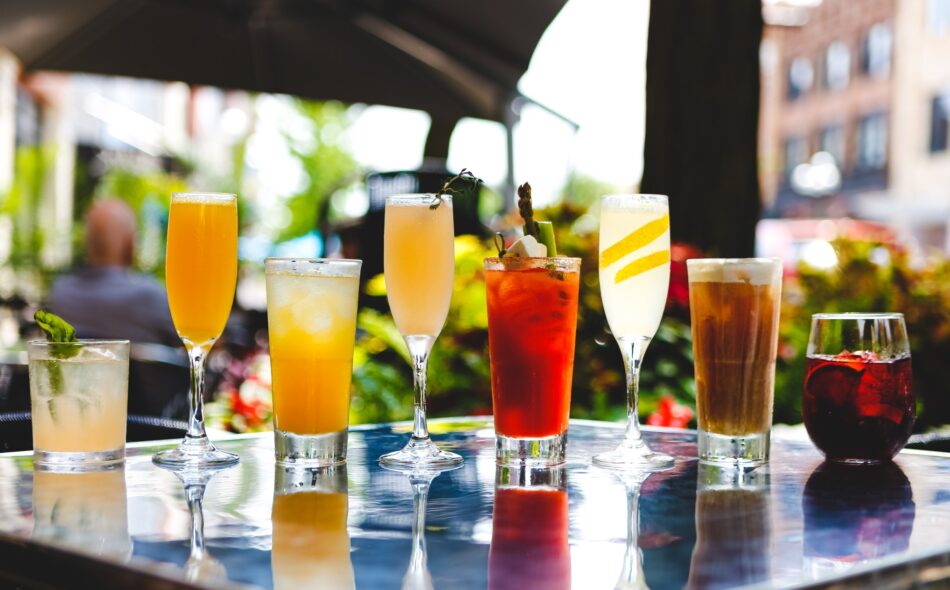Kir royale: France
This sweet cocktail is actually an upgrade of the popular French kir concoction. Invented in Burgundy and popularised by the Mayor of Dijon, Canon Félix Kir, the traditional kir aperitif is a combination of dry white wine and crème de cassis – a dark, sweet blackcurrant liqueur. The kir royale has a more celebratory feel thanks to the use of champagne in place of white wine, and it was rumoured to be Canon Kir’s favourite aperitif to serve at official receptions.

Sangria: Spain
The earliest incarnation of this kind of drink can be traced back to ancient Greek and Roman civilisations, where wine was mixed with sugar and spices. Today, however, the cocktail is most associated with Spain. This is thanks to the Roman occupation of the land around 200BC, when they imported vines and planted vineyards. The grapes flourished in the Mediterranean soil and so the Spanish wine industry was born. As water was unsafe to drink at this time, more palatable drinks were created, including this wine punch. Sangria is actually a variation on the Spanish word for blood (sangre) and is typically made with red wine, brandy, spices and fruit. For a twist on the recipe, try sangria blanca (made with white white) or sangria de cava (a bubbly version made with sparkling wine).

Pisco sour: Peru
Though there’s an ongoing disagreement regarding which country has the rights to this cocktail, most tend to agree it’s a signature Peruvian drink and not originally from Chile. The main ingredient – a potent brandy called pisco – is created in both countries but can be traced back to 16th-century Peru. The country had been invaded by the Spanish Conquistadors, who imported Spanish grapes and planted their own vineyards to create the distilled spirit. In the 1920s, the modern pisco sour cocktail, made with egg whites, lime and Angostura bitters, was created by Victor Vaughen Morris in a bar in Lima. The European Commission officially declared Peru as the owners of the pisco sour in 2013 and every year on the first Saturday in February the zesty national drink is celebrated with its own Pisco Sour Day. Citrusy and tart, this cocktail is a classic shaken concoction.

Sazerac: New Orleans
The sazerac was officially declared the signature tipple of New Orleans in 2008, but the cocktail has its roots in the 19th century. In the 1830s, Antoine Amédée Peychaud, who ran an apothecary, served his customers toddies made from his secret family recipe of bitters and cognac. His remedial drinks became so popular that a bar known as the Sazerac Coffee House purchased the rights to Peychaud’s bitters and swapped the cognac out for Sazerac rye whiskey. The official cocktail recipe has changed over the years but the dry, punchy flavour remains the same.

Pimm’s: London
The gin-based Pimm’s No. 1 Cup was originally used as a medicinal tonic and quickly developed into a phenomenon. In the 1840s, fishmonger and landlord James Pimm began marketing his own health tonic. Over the next 20 years, the tonic gained popularity as an enjoyable drink. By 1859, the Pimm’s No 1. Cup was being sold commercially and soon reached international waters in the British colonies of Australia, India, Canada and the Caribbean. Still immensely popular in Britain, around 200,000 individual Pimm’s cocktails – made by mixing the liquor with lemonade – are sold at Wimbledon each year. That’s a lot of gin for just two weeks of tennis.

Aperol Spritz: Venice
It may feel as though the Aperol Spritz appeared out of nowhere, but Venetians have been sipping this sweet, fizzy cocktail for decades. After the Napoleonic wars when Austria-Hungary occupied the Veneto region of Northern Italy, the German ‘spritz’ was introduced to the region by adding splashes of water to Italian wines. In 1919, Aperol was invented and marketed to sporty women, due to its low alcohol volume. It soon became the liquor of choice in a spritz cocktail, and by the 1950s Aperol had created its signature Spritz recipe.

Black russian: Brussels
Strong, dark and dreamy – the black russian cocktail was actually invented more than 1,000 kilometres (or 621 miles) from the capital city of its namesake. The story goes that back in Belgium in 1949, bartender Gustave Tops mixed up a signature drink for American Ambassador to Luxembourg, Perle Mesta. The combination of vodka and coffee liqueur was named ‘black russian’ due to its colour and the use of vodka, which was well-known as a popular Russian drink.

Cosmopolitan: New York City
Despite being somewhat of a late-comer to the cocktail party, the cosmopolitan is a regular on cocktail menus today. Launching onto the scene in the late ’80s and solidifying its status throughout the ’90s, the vodka, triple sec and cranberry concoction was reportedly a favourite among the gay scenes in Miami Beach and Provincetown in Massachusetts. People wanted a drink that had the class of a martini but was easier to drink, but much of the cosmo’s success and association with New York is due to its ubiquity in the cult Sex and the City TV series.

Mojito: Havana
The humble Mojito did not begin as the classy cocktail we know it to be today. It was a creative necessity due to the cheap but potent rum found all over Cuba. To make their drinks more palatable, locals would add lime juice, sugarcane and mint. It gained overseas recognition during the Prohibition era when Havana became a favourite among thirsty Americans. This was likely the time the drink gained a nod of approval from Ernest Hemingway, which perhaps solidified its status in the cocktail hall of fame.

Singapore sling: Singapore
This fruity and colourful cocktail was created with women in mind. In 1915, Ngiam Tong Boon, a bartender at the Raffles Hotel in Singapore noticed that while it was common for gentlemen to drink straight gin and whisky in the bar, it was not culturally acceptable for women to consume alcohol in public. Many women opted for tea or juice instead. That is until Boon created the singapore sling, concealing gin and liqueur in a juice-based cocktail. It was an undeniable hit and is now widely believed to be the national cocktail.

Margarita: Mexico
Nobody seems to agree on who invented the margarita, but it’s a well-known fact that it originated in Mexico. According to one story, it was a bar owner from Tijuana who created the first margarita to appease a dancer who only drank tequila but preferred not to take a shot. Another story tells the tale of Texas socialite Margaret Sames, aka Margarita, and the lavish parties she threw where the drink first came to be. The stories are endless, but while we may never know who put together the tart, zesty concoction, it now has its own national day in Mexico, on 22 February each year.


